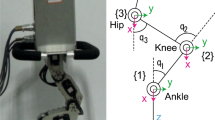Abstract
This study proposes a locomotion controller for a single-legged robot. The locomotion controller comprises five parts: virtual spring, height control, forward velocity control, body attitude control, and angular momentum control. First, we propose an effective method called a virtual spring to generate a springy force using a linear actuator. Two virtual springs are adopted to compute the energy exchange and to compensate the energy loss during hopping. A simple and intuitive method is proposed to implement resonance oscillation in terms of energy loss. A height controller is proposed based on the resonance oscillation using a virtual spring. In addition, a running direction controller, which has never been resolved in previous studies, is proposed. This novel controller can remove the unexpected angular momentum about the yaw direction during running. All of the proposed algorithms and methods are validated through dynamic simulations.
Similar content being viewed by others
References
C. T. Farley, J. Glasheen, and T. A. McMahon, “Running spring: speed and animal size,” The Journal of Experimental Biology, vol. 185, pp. 71–86, 1992.
G. A. Cavagna, N. C. Heglund, and C. R. Taylor, “Mechanical work in terrestrial locomotion: two basic mechanisms for minimizing energy expenditure,” American Journal of Physiology, vol. 233, pp. 243–261, 1977.
M. H. Raibert, Legged Robots That Balance, The MIT Press, 1986.
M. H. Raibert, “Hopping in legged systems-modeling and simulation for the two-dimensional one-legged case,” IEEE Transactions on Systems, Man, and Cybernetics, vol. SMC-14, no. 3, pp. 451–461, 1984.
M. Ahmadi and M. Buehler, “Controlled passive dynamic running experiments with the ARL-monopod II,” IEEE Transactions on Robotics, vol. 22, no. 5, pp. 974–986, 2006. [click]
K. Harbick and G. S. Sukhatme, “Controlling hopping height of a pneumatic monopod,” IEEE International Conference on Robotics & Automation, pp. 3998–4003, 2002. [click]
W. J. Schwind and D. E. Koditschek, “Control of forward velocity for a simplified planar hopping robot,” IEEE International Conference on Robotics and Automation, pp. 691–696, 1995.
N. Cherouvim and E. Papadopoulos, “Control of hopping speed and height over unknown rough terrain using a single actuator,” IEEE International Conference on Robotics and Automation, pp. 2743–2748, 2009. [click]
R. Smith, Open Dynamics Engine (ODE), http://www.ode.org
Gazebo, Open Source Robotics Foundation, http://gazebosim.org
V-REP, Virtual Robot Experimentation Platform, http://www.coppeliarobotics.com
Webots, Cyberbotics, http://www.cyberbotics.com
D. L. Jindrich and M. Qia, “Maneuvers during legged locomotion,” Chaos: An Interdisciplinary Journal of Nonlinear Science, 026105-19, 2009.
Author information
Authors and Affiliations
Corresponding author
Additional information
Recommended by Associate Editor Sooyeong Yi under the direction of Editor Hyouk Ryeol Choi. This work was supported by the DGIST R&D Program of the Ministry of Science, ICT and Future Planning of Korea (14-RS-02).
Tae Hun Kang received his B.S., M.S., and Ph.D. degrees from the Department of Mechanical Engineering, Sung Kyun Kwan University, Korea, in 2000, 2002, and 2006, respectively. From 2006 to 2011, he was team leader in PIRO (Pohang Institute of Intelligent Robotics), Pohang, Korea. He was Adjunct Professor with Yeung Nam University, Yeung Nam, Korea, from 2010 to 2012. Since 2013, he has been with DGIST (Daegu Gyeongbuk Institute of Science & Technology), Daegu, Korea. He is a Senior Research Scientist in DGIST. His interest includes Robot Design, Smart Factory, Rehabilitation Robot, Legged Robot, Field Application of Robot.
Jeon Il Moon received his B.S. degree in Mechanical Engineering, Seoul National University, Korea, in 1984, and received the M.S. degree in the major of Robot Control in Mechanical Engineering, KAIST(Korea Advanced Institute of Science and Technology) in 1986, and received the Ph.D. degree in Mechanical and Aerospace Engineering from Syracuse University, New York, U.S.A. in 1998. He was a team leader in R&D center of LG Industrial Systems from 1986 to 1993, and was the Director of R&D center of LG Industrial Systems until 2006. He was an associate professor and the dean of the department of Robotics Engineering, Hoseo University from 2007 to 2010. He is currently the Director of DGIST Convergence Research Institute and vice president of Research, DGIST. His current research interests include Health & Rehabilitation Robotics, Embedded Control & Intelligence Control, Robot Technology based Smart Factory.
Rights and permissions
About this article
Cite this article
Kang, T.H., Moon, J.I. Three-dimensional locomotion control of single-legged robot: Resonance hopping and running direction. Int. J. Control Autom. Syst. 14, 1331–1339 (2016). https://doi.org/10.1007/s12555-015-0128-6
Received:
Revised:
Accepted:
Published:
Issue Date:
DOI: https://doi.org/10.1007/s12555-015-0128-6




